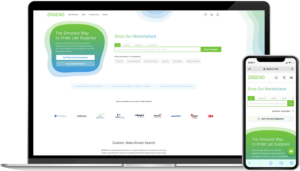Is Lab Supply Brand Loyalty Dead?

The lab supply marketing is undergoing a shift, from the products required by scientists to the way that they purchase and interact with their favorite vendors. As the demand for novel therapeutics in response to the pandemic continues to rise alongside the automation of the lab supply industry, independent suppliers need to build brand awareness. More importantly, though, they need to understand the best ways to get their products in front of the right audiences.
Brand loyalty, which used to be a key aspect of biotech R&D and supplier-lab relationships, is no longer relevant during a supply chain shortage, prompting lab managers to seek out new supplies elsewhere.
As a result, this deprioritization of brand loyalty poses an opportunity for growth for smaller and emerging vendors. With customers caring more about the availability of supplies than the reputation of suppliers, the lab supply playing field evens out.
In order for suppliers to capitalize on the changing buying landscape for growing biotech organizations, suppliers need to use a collection of marketing strategies to engage their customers. Here are a few ways that lab supply vendors can connect with new audiences by improving their product marketing.
The Decline of Lab Supply Brand Loyalty
Innovation doesn’t stop for supply chain disruptions. In the scientific world, when a certain material, ingredient, or piece of equipment is out of stock, the need for that supply doesn’t just vanish. Instead, lab managers and procurement teams are left scrambling to find a suitable replacement.
For example, in the early months of the COVID-19 pandemic, there was a shortage of PPE (including gowns, gloves, masks, and safety goggles) at healthcare and research facilities globally. To combat the shortage in supplies from their usual vendors, procurement teams ordered smaller shipments from an assortment of brands. All of the supplies ended up being different colors and styles than they were accustomed to, but they met their safety needs so that they could continue working.
Brand loyalty isn’t just affecting the scientific community. It is diminishing across industries and even seeping into the lives of individual consumers. For example, when hand sanitizer was out of stock in 2020, people who were once Purell brand loyalists turned to other brands that had product available and that had a high enough alcohol content to be effective against the Coronavirus.
If there’s one thing that has been made abundantly clear over the past couple of years, it’s that the need for PPE, pipette tips, and other high-demand supplies has not waned. In order to continue serving their customers with the tools they need to get their jobs done, lab supply vendors need to increase their product availability and ramp up marketing.
How to Improve Lab Supply Product Marketing
Product marketing for lab supplies includes public-facing marketing efforts and more technical, detailed descriptions on product pages. Any product-related content can be strategic, and work to attract scientific buyers by using the right language and keywords.
Here are three steps that lab supply vendors can take to improve product visibility and awareness.
Step 1: Make product descriptions applicable to multiple industries.
As the pandemic continues to affect the daily lives of the global workforce, lab supply vendors are realizing that their stock is pertinent to a wider audience than it was pre-pandemic.
In the scientific world, maybe lab procurement teams habitually purchased gloves from McKesson out of an obligation to brand loyalty. But, once those gloves were out of stock, procurement teams still needed to find product alternatives that met their needs and were available. Enter: smaller and emerging vendors without name recognition, but gloves in stock.
To reach an even wider audience, vendors can make product descriptions applicable to multiple industries. For example, outside of the scientific community gloves are still an essential supply for many professionals like cashiers, flight attendants, and bus drivers. By pivoting your marketing to include other industries, vendors gain access to a previously untapped demographic.
Step 2: Explore new verticals.
Increasing product availability requires vendors to seek out new customer terrain. Customers will be unable to purchase your supplies if they don’t even know you exist. By exploring new vertical markets, suppliers can ensure that they are exposing themselves to all potentially interested audiences.
Essentially, there’s no way of knowing if a certain market is right for your company until you are available to them. For example, if you previously served hospitals and healthcare facilities, you could expand to research facilities and scientific labs.
Step 3: Join a lab supply digital marketplace.
The final step toward complete product visibility is to ensure your supplies are as accessible as possible to a wide audience. For many small and emerging vendors, this step looks like joining a lab supply digital marketplace.
Digital marketplaces level the playing field for vendors of all shapes, sizes, and specialties by making it easy for vendors to be found. Customers are able to use marketplace search functions to shop by product availability and shipping preferences, which further removes the obstacle of brand loyalty.
Learn more about becoming a partner with ZAGENO.


